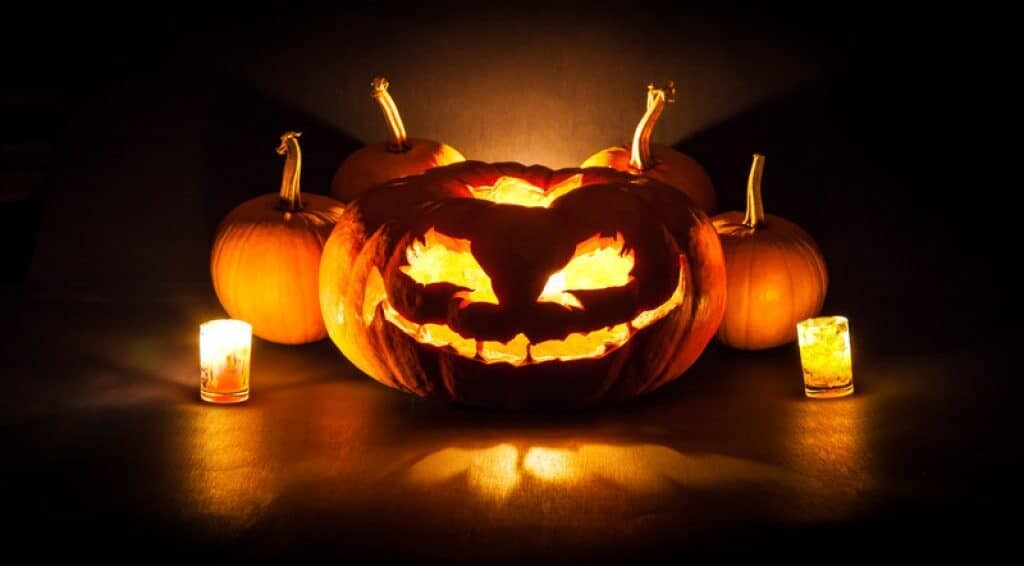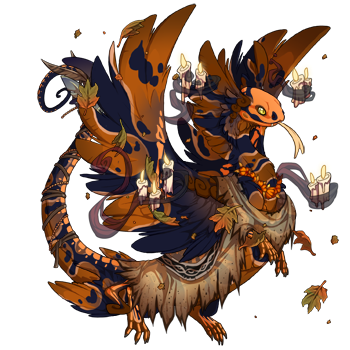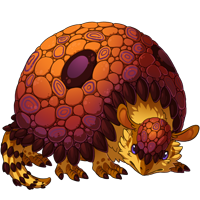

Askutasquash
(#75194129)
who lives but once a year, soul waiting to be lit aflame
Click or tap to view this dragon in Predict Morphology.
Energy: 46/50

Expand the dragon details section.
Collapse the dragon details section.
Personal Style
Apparel






Skin
Scene

Measurements
Length
7.97 m
Wingspan
7.26 m
Weight
916.47 kg
Genetics
Bronze
Python
Python
Bronze
Morph
Morph
Cantaloupe
Ghost
Ghost
Hatchday
Breed
Eye Type
Level 1 Coatl
EXP: 0 / 245


STR
6
AGI
7
DEF
6
QCK
7
INT
7
VIT
5
MND
6
Biography

Askútasquash
askꝏtasquash, squash, pôhpukun, pumpkin, cucurbita
green thing eaten raw, grows forth round, gourd
Cucurbita (Latin for gourd) is a genus of herbaceous vegetables in the gourd family, Cucurbitaceae (also known as cucurbits or cucurbi) native to the Americas. Five species are grown worldwide for their edible vegetable, variously known as squash, pumpkin, or gourd, depending on species, variety, and local parlance, and for their seeds. Pumpkins are one of the oldest domesticated plants in the world, having been cultivated as early as 8,000 years ago. Squash, along with maize and beans, has been depicted in the artwork of the Indigenous peoples of the Americas for at least 2,000 years, long before colonization, and was often represented on ceramics. The genus was part of the culture of almost every native peoples group from southern South America to southern Canada. Squash was domesticated first, followed by maize and then beans, becoming part of the Three Sisters agricultural system of companion planting. Following colonization, Cucurbita began to spread to other parts of the world. Other kinds of gourd, also called bottle-gourds, are native to Africa and belong to the genus Lagenaria, which is in the same family and subfamily as Cucurbita, but in a different tribe.
The term pumpkin has no agreed-upon botanical or scientific meaning, and is used interchangeably with "squash" and "winter squash". In North America and the United Kingdom, pumpkin traditionally refers to only certain round orange varieties of winter squash, predominantly derived from C. pepo, while in New Zealand and Australian English, the term pumpkin generally refers to all winter squash.
The English word "squash" derives from askutasquash, or a green thing eaten raw, from the Algonquian language family. Similar words for squash exist in related languages, variously transcribed as ashk8tasqash, askꝏtasquash in the Massachusetts language, or, askútasquash in Narragansett. The word "pumpkin" derives from the Massachusett word pôhpukun, meaning 'grows forth round'. This term would likely have been used by the Wampanoag people (who speak the Wôpanâak dialect of Massachusett) when introducing pumpkins to English Pilgrims at Plymouth Colony, located in present-day Massachusetts.
The ancestral species of the genus Cucurbita were present in the Americas before the arrival of humans, and the likely center of origin is southern Mexico, spreading south through what is now known as Mesoamerica, on into South America, and north to what is now the southwestern United States. Evolutionarily speaking, the genus is relatively recent in origin, dating back only to the Holocene. Archaeological investigations have found evidence of domestication of Cucurbita going back over 8,000 years from the very southern parts of Canada down to Argentina and Chile. Centers of domestication stretch from the Mississippi River watershed and Texas down through Mexico and Central America to northern and western South America. The domestication of squash thus predates the domestication of other crops such as maize and beans in the region by about 4,000 years. Genetic studies of the mitochondrial gene nad1 show there were at least six independent domestication events of Cucurbita separating domestic species from their wild ancestors. The earliest evidence for domestication was found in Oaxaca, Mexico; changes in fruit shape and colour indicate that intentional breeding of pumpkins (C. pepo) had occurred by no later than 8,000 years BP. Recent genomic studies suggest that Cucurbita argyrosperma was also domesticated in Mexico, in the region that is currently known as the state of Jalisco. Modern-day cultivated Cucurbita are not found in the wild.
Cucurbita species fall into two main groups. The first group are annual or short-lived perennial vines and are mesophytic, i.e. they require a more or less continuous water supply. Cultivated Cucurbita species are derived from this first group. The second group are perennials growing in arid zones and so are xerophytic, tolerating dry conditions. Growing 5 to 15 meters (15 to 50 ft) in height or length, the plant stem produces tendrils to help it climb adjacent plants and structures or extend along the ground. The vine of the perennial Cucurbita can become semi-woody if left to grow. There is wide variation in size, shape, and colour among Cucurbita fruits, and even within a single species, with few exceptions. The morphological variation in the species is so vast that various subspecies and cultivars may be misidentified as totally separate species.
There is debate about the taxonomy of the genus, as the number of accepted species varies from 13 to 30. The five domesticated species are Cucurbita argyrosperma, C. ficifolia, C. maxima, C. moschata, and C. pepo. Four of them, C. argyrosperma, C. ficifolia, C. moschata, and C. pepo, originated and were domesticated in North America, with the fifth, C. maxima, being domesticated in South America. All of these can be treated as winter squash because the full-grown fruits can be stored for months; however, C. pepo includes some cultivars that are better used only as summer squash. Species native to North America include the calabazilla, buffalo gourd, coyote melon, and pumpkin.
Most Cucurbita species are herbaceous vines that grow several meters in length and have tendrils, but non-vining "bush" cultivars of C. pepo and C. maxima have also been developed. The yellow or orange flowers on a Cucurbita plant are of two types: female and male. The female flowers produce the fruit and the male flowers produce pollen. Many North and Central American species are visited by specialist pollinators in the apid tribe Eucerini, especially the genera Peponapis and Xenoglossa, and these squash bees can be crucial to the flowers producing fruit after pollination; but other insects with more general feeding habits, such as honey bees, also visit.
Botanists classify the Cucurbita fruit as a pepo, which is a special type of berry. The term "pepo" is used primarily for Cucurbitaceae fruits, where this fruit type is common, but the fruits of Passiflora and Carica are sometimes also pepos. The seeds, which are attached to the wall (parietal placentation) and not to the center, are large and fairly flat. Fruit size varies considerably: wild fruit specimens can be as small as 4 centimetres (1+1⁄2 in) and some domesticated specimens can weigh well over 300 kilograms (660 lb). The current world record was set in 2014 in Switzerland with a 1,054.0-kilogram (2,323.7 lb) pumpkin.
Cucurbita fruits are large, fleshy, and are good sources of nutrients, such as vitamin A and vitamin C, among others. Although the stems and skins tend to be more bitter than the flesh, the fruits and seeds of cultivated varieties are quite edible and need little or no preparation. The flowers and young leaves and shoot tips can also be consumed. The seeds and fruits of most varieties can be stored for long periods of time, particularly the sweet-tasting winter varieties with their thick, inedible skins. Summer squash have thin, edible skin. The seeds of both types can be roasted, eaten raw, made into pumpkin seed oil, ground into a flour or meal, or otherwise prepared. Cucurbita fruits have many culinary uses including biscuits, bread, desserts, puddings, pies, oils, beverages, salads and soups.
C. foetidissima contains a saponin that can be obtained from the fruit and root. This can be used as a soap, shampoo, and bleach, however, prolonged contact can cause skin irritation. Pumpkins were traditionally used by Indigenous peoples to treat intestinal worms and urinary ailments. In southeastern Europe, pumpkin seeds were used to treat irritable bladder and benign prostatic hyperplasia. In China, C. moschata seeds were used in traditional Chinese medicine for the treatment of the parasitic disease schistosomiasis and for the expulsion of tapeworms. In Mexico, herbalists use C. ficifolia in the belief that it reduces blood sugar levels.
Cucurbita fruits, particularly pumpkins, have central roles in festivals celebrated all over the world. Most notable is the widely celebrated Halloween or All-Hallows-Eve, featuring jack-o'-lanterns ('Jack of the lantern') made of large orange pumpkins carved with ghoulish faces and illuminated from inside with candles. The practice of carving vegetables for Halloween is said to derive from the Irish legend of Stingy Jack, a drunkard barred from both Heaven and Hell, doomed to roam the Earth with only a hollowed turnip to light his way. The legend originates in the reported phenomena of strange lights flickering over peat bogs called will-o'-the-wisps ('Will of the torch') or ignis fatuus (foolish fire). Jack-o'-lanterns are also associated with Joan the Wad, the Cornish version of Will-o'-the-wisp, and is likewise regarded as a type of pixie.
In Gaelic-speaking regions, Halloween was also the festival of Samhain and was seen as a time when supernatural beings (the Aos Sí) and souls of the dead walked the earth. In this context, jack-o'-lanterns were said to represent either the dead souls and supernatural beings or were used to ward off evil spirits. The lanterns could be used to frighten people or be placed on windowsills to keep spirits out. Some believed jack-o-lanterns were also a way of protecting one's home against the undead, specifically vampires. It was thought that the jack-o-lantern's light was a way of identifying vampires who, once their identity was known, would give up their hunt for you. It has also been suggested that the jack-o'-lanterns originally represented Christian souls in purgatory, as Halloween is the eve of All Saints' Day/All Souls' Day (November 1st/2nd).
The term jack-o'-lantern first appears as a term for a carved vegetable lantern in 1836. Traditionally Britain and Ireland would carve the lanterns from root vegetables, particularly the turnip, mangelwurzel, or swede. Traditional vegetables continue to be popular choices today as carved lanterns in Scotland and Northern Ireland. The Hoberdy's Lantern (Hobbedy's Lantern, Hobbady-lantern, Hobany's (Hob and his), Hob-o'-Lantern) of Worcestershire, England, is one such tradition that continued to use turnips rather than the newly popular pumpkins that would come to represent jack-o-lanterns.
Later immigrants to North America began to use the native pumpkin for their lanterns, as they were both readily available, much larger, and easier to carve than turnips. In North America, the pumpkin was primarily associated with the harvest season in general and is only first recorded in association with Halloween in 1866, although the term jack-o'-lantern is applied to carved pumpkins as early as 1834. Adaptations of the American short story "The Legend of Sleepy Hollow" (1820) by Washington Irving often show the Headless Horseman with a pumpkin or jack-o'-lantern in place of his severed head, whereas in the original story, a shattered pumpkin is discovered next to Ichabod Crane's abandoned hat on the morning after Crane's supposed encounter with the Horseman.
Pumpkins continue to be associated with harvest time in North America and maintain a central role in both Halloween and Thanksgiving celebrations. This has led to a notable trend in pumpkin and spice-flavoured food products in North America, despite the fact that North Americans rarely buy whole pumpkins to eat other than when carving jack-o'-lanterns.
Other pumpkin celebrations include 'pumpkin chunking', a competitive activity in which teams build various mechanical devices designed to throw a pumpkin as far as possible, and competitions to grow the most massive pumpkins.
Autumn Equinox
wheat, maize, pumpkin, maple, poppy
wheat, maize, pumpkin, maple, poppy
Click or tap a food type to individually feed this dragon only. The other dragons in your lair will not have their energy replenished.
This dragon doesn't eat Insects.
This dragon doesn't eat Meat.
Feed this dragon Seafood.
This dragon doesn't eat Plants.
Exalting Askutasquash to the service of the Lightweaver will remove them from your lair forever. They will leave behind a small sum of riches that they have accumulated. This action is irreversible.
Do you wish to continue?
- Names must be longer than 2 characters.
- Names must be no longer than 16 characters.
- Names can only contain letters.
- Names must be no longer than 16 characters.
- Names can only contain letters.










